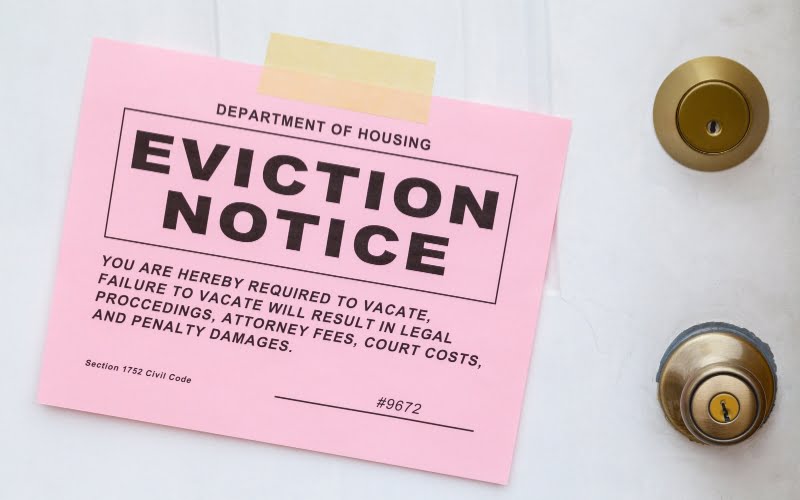Last Updated on March 18, 2024 by Kelvin Nielsen
Are you looking to evict a family member with no lease from your California home? If so, this article covers everything you need to know!
You may want to evict a family member from your home for multiple reasons, from failure to pay rent, to property damage, to illegal activity, to repeated violations of the lease. The reasons could be many and varied!
Regardless of the reason, though, you must strictly follow the proper process when evicting a family member with no lease in California. You must not resort to illegal eviction methods like locking out the tenant or removing their personal belongings.
The penalty for illegal eviction can be quite significant in California. You may be subject to a number of penalties, including punitive damages, actual damages, criminal penalties, as well as the tenant’s court and attorney fees.
With that in mind, how do you exactly evict a family member with no lease from your California home?
Evicting A Family Member With No Lease in California
Before starting the eviction process, first be sure that the tenant has no lease. Just because you didn’t give the tenant any document to sign won’t necessarily mean that there is no lease existing between the both of you.
You see, under California law (CA Civil Code 1940-1954.06), a lease can occur in either of three ways. That is, if there is a written text, an oral agreement, or if the landlord accepts a payment as rent.
Once that is done, the tenant automatically acquires all rights and responsibilities under California law. And to evict such a tenant, you’d generally need to have either of two reasons.
One, a legal justification to evict the tenant such as failing to pay rent. Or two, serve the tenant proper notice and then wait for the lease (which is typically month-to-month) to end.
However, if the family member doesn’t qualify as a tenant under California law, then the following is the step-by-step process you’d need to evict them.
Step #1: Serve the family member with a 30/60-Day Notice to Vacate.
If the tenancy is less than a year old, you must serve the tenant a 30 calendar days’ notice to vacate. But where the tenancy is 1 year or more, you must serve the tenant with a 60 calendar days’ notice to vacate.
Step #2: File an eviction lawsuit with the Superior Court of the applicable county in California.
If the notice period ends and the family member is still on the property, you can continue with their eviction by filing an eviction lawsuit against them. In court, you’ll need to file an Unlawful Detainer lawsuit.
Step #3: Have the family member served with a copy of the Summons and Complaint.
You have up to 60 days to have the tenant served after filing the eviction complaint.
Once this is done, the tenant will then have a chance to respond to the allegations. They may choose to do so by fighting their eviction. They may allege, for instance, that the eviction process was illegal, the eviction notice was marred with irregularities, or that they indeed had a lease.
If the tenant fails to respond, you can ask the court for a default judgment without having to attend the hearing. However, if the tenant did respond, then you’ll need to file a hearing request.
Step #4: Attend the court hearing.
Typically, eviction hearings in California are held within 20 days of filing a hearing request. It goes without saying that you should adequately prepare for the hearing by carrying all relevant evidence.
Including, a copy of the eviction notice, summons and complaint, and even witnesses (if any).
If the outcome of the hearing is in your favor, you’ll need to obtain a Writ of Execution.
Step #5: Removal of the tenant.
A Writ of Execution is the tenant’s final notice to leave the property. In California, a Writ of Execution gives a tenant up to 5 days to leave. After that, the sheriff will have to forcibly eject them (if necessary) and return possession back to the landlord.
The family member may also be able to delay their eviction by filing a stay of execution.
Frequently Asked Questions (FAQs): Evicting a Family Member With No Lease in California
Q: How long does it take to evict a family member in California?
A: You can expect the eviction process to take between 5 and 8 weeks. The exact period will depend on multiple reasons, including whether the tenant fights the eviction, or requests a continuance or jury trial.
Q: How do I evict my daughter from my home in California?
A: If you need to evict a child from your home, you’ll need to serve them either a 30 or 60 days’ eviction notice. If they have been staying with you for one year or less, you must give them a 30 days’ notice. If they have been staying with you for more than a year, then you must serve them a 60 days’ eviction notice.
If they leave within this period, great! But if they don’t, you can choose to go to court and file an eviction lawsuit against them. (The rest of the process is as aforementioned in this blog).
Q: What rights do tenants have without a lease in California?
A: Generally speaking, whether there is a lease or not, all tenants enjoy equal rights. So, even without a lease, the tenant still has a right to habitable living conditions, right to privacy, right to security deposit refund, right to notice before eviction, and right to defend against unlawful eviction.
For a full overview of the rights tenants have in California, here is a guide to get you started.
Q: How much does it cost to legally evict someone in California?
A: The exact cost will depend on a boatload of factors. Including, the specific reason for the eviction, the property’s location, and the complexity of the case.
Generally speaking, though, expect to fork out anywhere between $500 and $3,000 to evict a tenant. The following is the general breakdown of the fees.
- Filing fees: $350
- Service fees: up to $100
- Attorney fees: ~$1000
- Court costs: from a few hundred dollars to several thousand dollars
Q: Is a verbal rental agreement legally binding in California?
A: Absolutely! A verbal rental agreement is legally binding in California, especially if it is one year or less. That said, verbal agreements are usually prone to a myriad of issues. For instance, it can be difficult to prove what was agreed by both parties regarding rent payments, late fees, pet policies, guest rules, or other lease terms.
Ideally, it’s always best for a landlord to have a written agreement that specifically outlines both parties’ rights and responsibilities.
Q: Can you evict a tenant for a family member to move in California?
A: Yes, you can evict a tenant for a family member to move in. California law requires that a landlord serve the tenant with at least 60 days’ notice if they need to move into the property themselves or to a family member.
Please note, however, that you cannot break the lease under false pretense. For example, breaking the lease simply because you want to rent out the property to someone else for a higher rent amount. You must also continue maintaining the property until the tenant has moved out.
Conclusion
There you have it, everything you need to know when evicting a family member with no lease in California. Remember, to successfully evict them, you must first obtain a court order. And even then, it’s only the sheriff that can carry out the eviction. Trying to evict the tenant in any other way will not only flop but may also guarantee you a date in court.
Disclosure: The content herein isn’t a substitute for advice from a professional attorney. It’s only meant to serve educational purposes. If you have a specific question, kindly seek expert attorney services.
Sources: CA Civil Code 1940-1954.06, 30-Day Notice to Quit, Nolo.com, California Tenant Protection Act,

Hi, I’m Kelvin Nielsen, an experienced landlord and accomplished real estate lawyer. My focus is on answering your questions about renting in the hopes of making your life as a renter or a landlord a bit easier.







